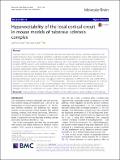Hyperexcitability of the local cortical circuit in mouse models of tuberous sclerosis complex
Author(s)
Zhao, Jian-Ping; Yoshii, Akira
Download13041_2019_Article_427.pdf (1.946Mb)
PUBLISHER_CC
Publisher with Creative Commons License
Creative Commons Attribution
Terms of use
Metadata
Show full item recordAbstract
Tuberous sclerosis complex (TSC) is a neurogenetic disorder associated with epilepsy, intellectual disabilities, and autistic behaviors. These neurological symptoms result from synaptic dysregulations, which shift a balance between excitation and inhibition. To decipher the synaptic substrate of hyperexcitability, we examined pan-neuronal Tsc1 knockout mouse and found a reduction in surface expression of a GABA receptor (GABAR) subunit but not AMPA receptor (AMPAR) subunit. Using electrophysiological recordings, we found a significant reduction in the frequency of GABAR-mediated miniature inhibitory postsynaptic currents (GABAR-mIPSCs) but not AMPAR-mediated miniature excitatory postsynaptic currents (AMPAR-mEPSCs) in layer 2/3 pyramidal neurons. To determine a subpopulation of interneurons that are especially vulnerable to the absence of TSC1 function, we also analyzed two strains of conditional knockout mice targeting two of the prominent interneuron subtypes that express parvalbumin (PV) or somatostatin (SST). Unlike pan-neuronal knockout mice, both interneuron-specific Tsc-1 knockout mice did not develop spontaneous seizures and grew into adults. Further, the properties of AMPAR-mEPSCs and GABAR-mIPSCs were normal in both Pv-Cre and Sst-Cre x Tsc1fl/fl knockout mice. These results indicate that removal of TSC1 from all neurons in a local cortical circuit results in hyperexcitability while connections between pyramidal neurons and interneurons expressing PV and SST are preserved in the layer 2/3 visual cortex. Our study suggests that another inhibitory cell type or a combination of multiple subtypes may be accountable for hyperexcitability in TSC. Keywords: Tuberous sclerosis complex; E/I balance; AMPA receptor; GABA receptor; Autism; Epilepsy; mTOR pathway
Date issued
2019-01Department
Massachusetts Institute of Technology. Department of Brain and Cognitive Sciences; Massachusetts Institute of Technology. Media Laboratory; McGovern Institute for Brain Research at MITJournal
Molecular Brain
Publisher
BioMed Central
Citation
Zhao, Jian-Ping and Akira Yoshii. "Hyperexcitability of the local cortical circuit in mouse models of tuberous sclerosis complex." Molecular Brain 12 (January 2019): 6 © 2019 The Author(s)
Version: Final published version
ISSN
1756-6606